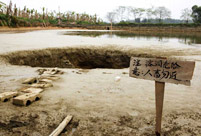

Yangtze tops dangerous 1998 level as Three Gorges drains
Water levels in a total of 61 rivers across China have exceeded flood warning levels so far this year, and the Three Gorges Reservoir is draining some of its stored water to brace for possible larger floods this summer, water resources authorities said.
Many major watercourses including the Ganjiang River in East China's Jiangxi Province, the Xiangjiang River in Central China's Hunan Province, the Beijiang River in South China's Guangdong Province and the Beiliu River in South China's Guangxi Zhuang Autonomous Region have reached extremely severe flood control conditions, China National Radio (CNR) reported.
Southern China has witnessed seven heavy rainstorms this spring, resulting in the highest precipitation levels in five years, CNR reported.
According to statements Yang Kun - an official with the Office of State Flood Control and Drought Relief Headquarters - made to China Central Television on Wednesday, the water level along the middle and lower reaches of the Yangtze River was up to 3.52 meters higher than the historical average and 2.31 meters higher than the water level in 1998, when heavy flooding of the Yangtze killed 1,320.
Yang said that the higher water level was partially due to more rainfall, and also in part due to the draining of the Three Gorges Reservoir to prepare for heavy flooding this year.
Chinese authorities have warned since late March that heavy floods are very likely on the Yangtze River this year.
Water experts said that the floods expected this year, though quite similar to the 1998 flooding, are unlikely to cause similar consequences due to China's improved flood control capabilities.
"China has built more water projects since 1998, including the Three Gorges Dam, which can adjust the peak flood level of the Yangtze River quickly, and the overall flood control situation will be a lot better," Ma Jun, director of the Institute of Public and Environmental Affairs, told the Global Times.
Liu Ning, China's vice minister of water resources, said in late March that heavy flooding this year is due to a prolonged, strong El Nino effect, the Xinhua News Agency reported.
Liu said that meteorological and hydrological analysis shows the El Nino event, which began in September 2014, has been the longest and strongest of its kind since observations began being recorded in 1951.
Several key tributaries along the Yangtze River, such as Dongting Lake and Poyang Lake, face more pressure caused by a high riverbed, Ma said. "The authorities need to pay special attention to many small dams and reservoirs in the tributaries, which are of poor quality and have been improperly maintained, as any collapse or break could worsen the flood situation downstream."
 The evolution of J-10 fighter
The evolution of J-10 fighter Top 10 Asian beauties in 2016
Top 10 Asian beauties in 2016 What's happening in Xisha Islands?
What's happening in Xisha Islands? When female soldiers meet flowers
When female soldiers meet flowers North Sea Fleet conducts drill in West Pacific Ocean
North Sea Fleet conducts drill in West Pacific Ocean Old photos record the change of Sichuan over a century
Old photos record the change of Sichuan over a century Breathtaking aerial photos of tulip blossoms in C China
Breathtaking aerial photos of tulip blossoms in C China Horrific: Pit swallows 25 tons of fish overnight
Horrific: Pit swallows 25 tons of fish overnight Vietnamese Su-30 fighters fly over Nanwei Island in South China Sea
Vietnamese Su-30 fighters fly over Nanwei Island in South China Sea Top 20 hottest women in the world in 2014
Top 20 hottest women in the world in 2014 Top 10 hardest languages to learn
Top 10 hardest languages to learn 10 Chinese female stars with most beautiful faces
10 Chinese female stars with most beautiful faces China’s Top 10 Unique Bridges, Highways and Roads
China’s Top 10 Unique Bridges, Highways and Roads When can a fan call it quits
When can a fan call it quits Expats aim for the silver screen
Expats aim for the silver screen Press freedom index hides absurd logic
Press freedom index hides absurd logic Toxic campus scandal tests govt ability to build public trust
Toxic campus scandal tests govt ability to build public trustDay|Week